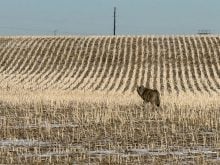Prairie farmers were probably expecting the worst when they provided yield estimates to Statistics Canada in the first two weeks of September.
As a result, say market analysts, both the wheat and the canola numbers contained in the agency’s production forecast last week probably understate the actual size of the crops.
“The general belief in the trade is that this was done when farmers were at their most pessimistic,” said Nolita Clyde of Ag Commodity Research, who tracks canola markets.
She said the feedback since mid-September has been that canola yields are turning out to be better than expected in most areas.
Read Also

Agritechnica Day 2: The future of tractor power, building quicker crop apps and large farms and tech
Agritechnica Day 2: The future of tractor power, building quicker crop apps with Syngenta and large farms and tech
Glenn Lennox, market analyst with Agriculture Canada, agreed, saying that “in all probability” farmers underestimated their wheat production as well.
“The first reaction is to be very negative when you see the frost,” he said. “This is still a pre-harvest number, so it definitely has the potential to change significantly.”
When the survey was conducted from Sept. 1-14, farmers were still reeling from the killer frost that struck large areas of Saskatchewan and Manitoba Aug. 20. The weather was cool and wet and the crop was immature and progressing slowly.
The Statistics Canada report pegs the total output of the six major grains and oilseeds, plus dry peas, at 49 million tonnes. That’s down 6.5 percent from its July 15 estimate of 52.4 million tonnes.
The wheat crop, including durum, was estimated to be 22.6 million tonnes, down from the July estimate of 23.7 million. Yields were estimated at 35.4 bushels per acre, down from 41.9 bu. projected in July.
Canola output was projected to be 6.9 million tonnes, down from 8.2 million in July, based on yields of 25.2 bu. per acre, down from 28.5 bu.
Clyde said the canola trade had been expecting to see a number in the range of 6.8 to eight million tonnes.
Statistics Canada’s own report cautions that its September forecast underestimates final output eight years out of 10, by an average of 4.5 percent. That alone would be enough to push actual production up to about 7.2 million tonnes.
“Most traders would probably still expect 7.3 million, maybe a little higher,” said Clyde, adding she’s sticking with a forecast of 7.6 million.
If the trade believed the government agency number, market prices would have risen, but in fact they opened lower the day after the figures were released, following the lead of soybean prices on the Chicago Board of Trade.
The price outlook for the year continues to be bearish, driven by large world supplies of soybeans, rapeseed and canola, and disappointing demand.
Spring wheat prices on the Minneapolis Grain Exchange didn’t react at all to the Statistics Canada report because it was in line with expectations, said Lennox.
He said the durum production estimate of 4.7 million tonnes was actually a bit higher than expected.
“That’s a bit of a surprise because we had assumed it would be more impacted by the frost and cool weather in August, but apparently it wasn’t,” he said.














